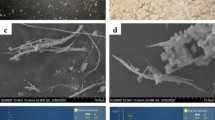Abstract
Twelve fungi were isolated and identified from air-conditioned rooms. Of the 12, 7 were species of Aspergillus, viz. A. niger, A. oryzae, A. fumigatus, A. terreus, A. nidulans, A. versicolor and A. parasiticus. Other fungi were Penicillium citrinum, Fusarium oxysporum, Trichoderma viride, Neurospora crassa and Alternaria alternata. A. niger was present in 80% of the locations. Some of the fungi isolated in this study could be opportunistic fungal pathogens, like A. fumigatus, A. niger and Penicillium citrinum, and were found to be allergenic. Results of this study indicate that air-conditioned rooms could be reservoirs of fungi and may cause allergic problems or infections in healthy or immunocompromised individuals living in these environments.
Similar content being viewed by others
References
Anon (2007) Indian Pharmacopoeia, 5th edn. Government of India
Austen, B. H., McCarthy, B., Wilkins, A., Smith, & Duncombe, A. (2001). Fatal disseminated Fusarium infection in acute lymphoblastic leukaemia in complete remission. Journal of Clinical Pathology, 54, 488–490. doi:10.1136/jcp.54.6.488.
Bren, A. (1998). Fungal peritonitis in patients on continuous ambulatory dialysis. European Journal of Clinical Microbiology and Infectious Diseases, 17, 839–843. doi:10.1007/s100960050203.
Cho, S. H., Reponen, T., Le Masters, G., Levin, L., Huang, J., Meklin, T., et al. (2006). Mold damage in homes and wheezing in infants. Annals of Allergy, Asthma & Immunology, 97(4), 539–545.
Cooley, J. D., Wong, W. C., Jumper, C. A., & Straus, D. C. (1998). Correlation between the prevalence of certain fungi and sick building syndrome. Occupational and Environmental Medicine, 55, 579–584. doi:10.1136/oem.55.9.579.
de Hoog, G. S., Guarro, J., Gene, J., & Figueras, M. J. (2000). Atlas of Clinical Fungi (2nd ed., Vol. 1). Utrecht, The Netherlands: Centralbureau voor Schimmel cultures.
Diette, G. D., Hansel, N. N., Buckley, T. J., Brosnan, J. C., Eggleston, P. A., Matsui, E. C., et al. (2007). Home indoor pollutant exposures among inner-city children with and without asthma. Environmental Health Perspectives, 115(11), 1665–1669.
Domsch, K. H., Gams, W., & Anderson, T. H. (1980). Compendium of Soil Fungi. Vol. I and II. London: Academic Press.
Gilliam, J. S., & Vest, S. A. (1952). Penicillium infection of the urinary tract. The Journal of Urology, 65, 484–489.
Goh, J. C. C., Juliana, J., Malina, O., Ngah, Z. U., & Norhafizalena, O. (2007). Prevalence of Penicillium specific Ig E level and allergy symptoms among office workers in a selected company in Bangi, Malaysia. Tropical Biomedicine, 24(1), 37–46.
Green, B. J., Schmechel, D., & Tovey, E. R. (2005). Detection of aerosolized Alternaria alternata conidia, hyphae and fragments by using a novel-immunostaining technique. Clinical and Diagnostic Laboratory Immunology, 12(9), 1114–1116. doi:10.1128/CDLI.12.9.1114-1116.2005.
Groll, A. H., & Walsh, T. J. (2001). Uncommon opportunistic fungi: New nosocomial threats. Clinical Microbiology & Infection, 7, 8–24. doi:10.1111/j.1469-0691.2001.tb00005.x.
Guarro, J., & Gene, J. (1995). Opportunistic fusarial infections in humans. European Journal of Clinical Microbiology and Infectious Diseases, 14(9), 741–754. doi:10.1007/BF01690988.
Gugnani, H. C., Gupta, S., & Talwar, R. S. (1978). Role of opportunistic fungi in ocular infection in Nigeria. Mycopathologia, 65, 155–166. doi:10.1007/BF00447186.
Howard, D. H. (2003). Pathogenic fungi in humans and animals (2nd edn). Marcel Dekker, New York
Kwon-Chung, K. J., & Bennett, J. E. (1992). Medical Mycology. Philadelphia and London: Lea & Febiger.
Lowry, O. H., Roshbrough, N. J., Farr, A. L., & Randall, R. J. (1951). Protein measurement with the Folin phenol reagent. The Journal of Biological Chemistry, 193, 265.
Mitchell, C. S., Zhang, J., Sigsgaard, T., Jantunen, M., Lioy, P. J., Samson, R., et al. (2007). Current state of the science: Health effects and indoor environmental quality. Environmental Health Perspectives, 115(6), 958–964.
Mok, T., Koehler, A. P., Yu, M. Y., Ellis, D. H., Johnson, P. J., & Wickham, N. W. R. (1997). Fatal Penicillium citrinum pneumonia with pericarditis in a patient with acute leukemia. Journal of Clinical Microbiology, 35(10), 2654–2656.
Ortoneda, M., Guarro, J., Madrid, M. P., Caracuel, Z., Roncero, M. I. G., Mayayo, E., et al. (2004). Fusarium oxysporum as a multihost model for the genetic dissection of fungal virulence in plants and mammals. Infection and Immunity, 72(3), 1760–1766. doi:10.1128/IAI.72.3.1760-1766.2004.
Portnoy, J. M., Barnes, C. S., & Kennedy, K. (2005). Sampling for indoor fungi, current reviews of allergy and clinical immunology. The Journal of Allergy and Clinical Immunology, 13, 189–198.
Raper, K. B., & Fennell, D. I. (1965). The genus Aspergillus. Baltimore: Williams & Wilkins.
Salo, P. M., Arbes, S. J., Sever, M., Jaramillo, R., Cohn, R. D., London, S. J., et al. (2006). Exposure to Alternaria alternata in US homes is associated with asthma symptoms. The Journal of Allergy and Clinical Immunology, 118(4), 892–898. doi:10.1016/j.jaci.2006.07.037.
Samet, J. M., & Spengler, J. D. (2003). Indoor environments and health: Moving into the 21st century. American Journal of Public Health, 93(9), 1489–1493. doi:10.2105/AJPH.93.9.1489.
Samson, R. A., & Pitt, J. I. (2000). Integration of modern taxonomic methods for Penicillium and Aspergillus classification. Amsteldijk: Harwood Academic Publishers.
Seitz, C. S., Brocker, E. B., & Trautmann, A. (2008). A high school gym-induced disease. British Journal of Sports Medicine, 42, 998–999. doi:10.1136/bjsm.2007.042143.
Simon, B. N., Denk, U., Poll, V., Rid, R., & Michael, B. (2008). The spectrum of fungal allergy. International Archives of Allergy and Immunology, 145, 58–86. doi:10.1159/000107578.
Vennewald, I. M., Henker, E. K., & Seebacher, C. (1999). Fungal colonization of the paranasal sinuses. Mycoses, 42, 3–36. doi:10.1046/j.1439-0507.1999.00260.x.
Yoshikawa, S., Tsushima, K., Koizumi, T., Kubo, K., Kumagai, T., & Yamazaki, Y. (2005). Hypersensitivity Pneumonitis induced by spores of Penicillium citrinum in a worker cultivating Enoki mushroom. Internal Medicine, 45(1646), 537–541.
Acknowledgments
C.M. and I.K.K. are grateful to CSIR and MoEF, New Delhi, for financial support.
Author information
Authors and Affiliations
Corresponding author
Rights and permissions
About this article
Cite this article
Khan, A.A.H., Karuppayil, S.M., Manoharachary, C. et al. Isolation, identification and testing for allergenicity of fungi from air-conditioned indoor environments. Aerobiologia 25, 119–123 (2009). https://doi.org/10.1007/s10453-009-9114-x
Received:
Accepted:
Published:
Issue Date:
DOI: https://doi.org/10.1007/s10453-009-9114-x




